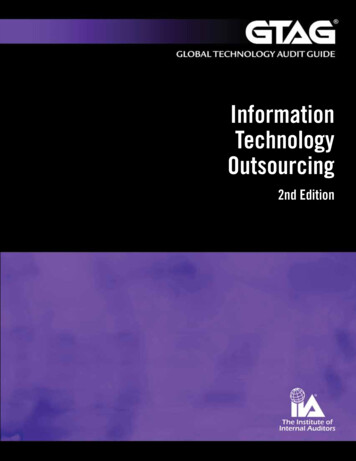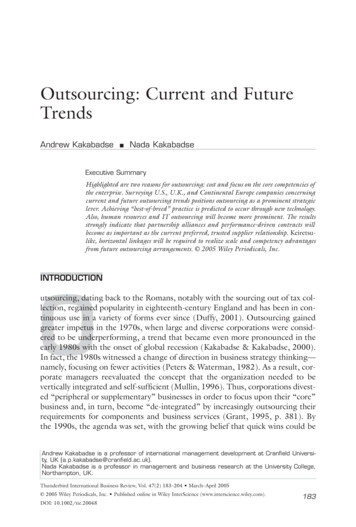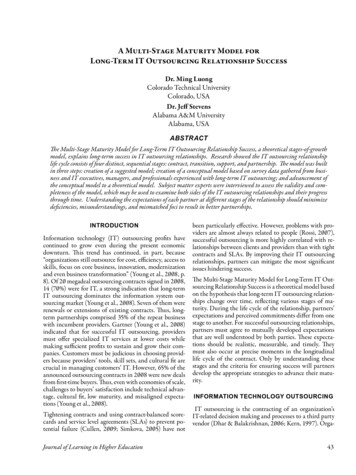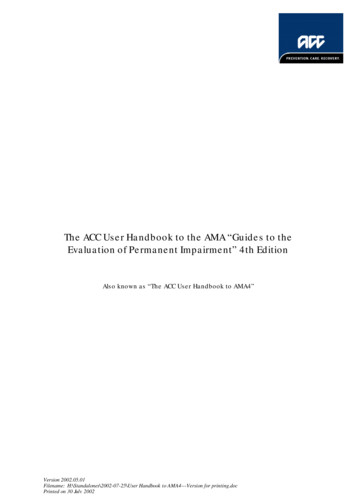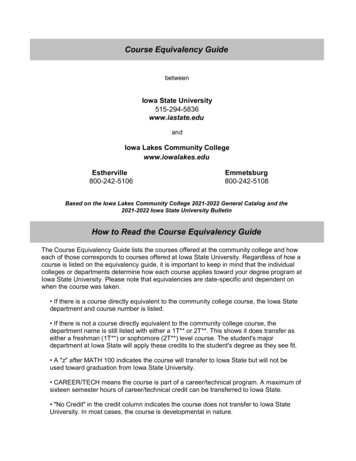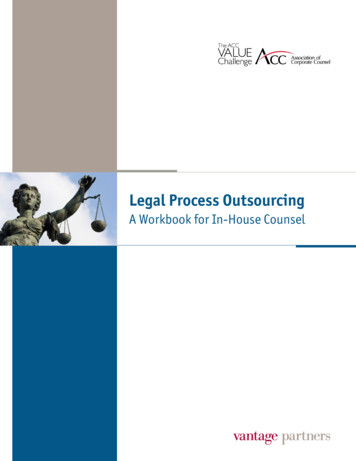
Transcription
Legal Process OutsourcingA Workbook for In-House Counsel
Table of contentsWhat might I outsource, and why?Why outsource legal processes? (Hint: If you are not sure, don’t.).2Ways in which in-house counsel can achieve value through outsourcing.2Practical tips for exploring LPO within your law department.5What might I outsource: Advice from your peers .6Taking the next stepWhy build a business case early. 10Practical tips on building the business case for LPO. 11Picking the right partnerWhat is different about choosing an LPO provider. 14Practical tips for provider selection. 15Provider selection criteria: Advice from your peers. 19Making it workRemember: LPO often requires a three-way relationship. 21Practical tips for managing LPO relationships effectively. 21Additional resourcesLinks to templates and other resources. 24Created for ACC and re-printed with the permission of Vantage Partners.
Vantage Partners LPO WorkbookThis workbook is designed to guide in-house counsel as theyconsider whether and how to improve the operation of theirlaw departments through legal process outsourcing (“LPO”).While there are great opportunities to improve the quality,efficiency, and impact of your law department through LPO, theproviders are not all alike, their offerings do not all solve forthe same problems, and there is no one-size-fits-all solution.Making the right decision for your law department requires:hhCareful consideration of your objectives in even consideringoutsourcing.hhCreation of a business case which reflects the real costsand benefits of outsourcing.hhA structured process for engaging the LPO provider market.hh(Should you decide to outsource) the ability to manageTo help you identify potential opportunities and evaluatethem, this workbook is organized into four sections, eachreflecting a key step in the exploration of LPO.Within each section we have included a set of resources tohelp you understand and manage your exploration of LPO,including: practical “how to” checklists for each step in theLPO exploration process; a number of tools and templates tohelp you along; and input gathered from your peers duringACC’s 2011 Annual Meeting. The data from the ACC session,“Lessons Learned Across the Legal Process OutsourcingLifecycle,” will allow you to see how your colleagues thoughtabout some of the key questions we’ll be posing in thisworkbook; their ideas represent a good starting place foryour own thinking about LPO.this new type of relationship effectively over time.What might Ioutsource, andwhy?Where are thereopportunities?Is there enoughvalue?Note:Taking the nextstepPicking the rightpartnerBuilding theinternalbusiness caseEngagingwithin theorganizationInstituting astructuredprocessEngagingproviders andtesting for theirability to meetyour goalsMaking it workManaging LPOrelationshipsEffectivelyengagingoutside counselabout LPOAll tools and templates included in this workbook are available in usable form from Vantage Partners, www.vantagepartners.com.Please see V. Additional resources.Copyright 2012 Vantage Partners, LLC. All rights reserved.1
I. What might I outsource, and why?This section describes some reasons why consideration of outsourcing is rising among in-house law departmentsand major law firms, as well as some of the key questions to ask yourself about whether legal process outsourcingmakes sense for your law department.Why outsource legal processes? (Hint: If you are not sure, don’t.)Even though the outsourcing underway in in-house law departments and law firms represents a very limited application of amanagement tool long used by other corporate functions such as IT, Finance, Human Resources, and Procurement, the discussionabout whether and how to outsource legal processes has spilled into the mainstream media in the past year or so, with articles inThe New York Times, The Wall Street Journal, and The Economist, to name a few. While both mainstream and legal industry mediaseem to treat legal outsourcing as a singular phenomenon and take sides in some supposedly momentous debate about whetherlaw departments and law firms should or should not engage in it, the reality is that outsourcing is a broad term encompassinga range of different business structures that law departments and law firms (like any other business) may choose to implementdepending on their business objectives. Indeed, most law departments already outsource work — to law firms.The real question is whether there is a better or smarter way to match the right work to the right resources. That explorationstarts with a critical question:For what purpose (or with which priorities) would you consider unbundling matters or services and reassigningsome of the work?There are certainly benefits to be obtained by outsourcing some tasks or services, and there are risks to doing so. Many hourshave been spent negotiating contracts to try to reap those benefits and manage those risks, but experience shows thatoutsourcing the wrong things for the wrong reasons is a far greater a source of dissatisfaction than picking the wrong provideror negotiating the wrong terms.1Outsourcing is a management tool that can be used to achieve different management objectives. And while outsourcing cansave you money, cost reduction is certainly not the only reason to outsource. If you look at only cost reduction, you miss asignificant part of the equation, but if you reach for other benefits without thinking through some of the inherent trade-offs,you may miss out on a significant part of the savings you expected.Ways in which in-house counsel can achieve value through outsourcingIn-house counsel have some interesting options available when it comes to outsourcing. To take advantage of them, however,make sure that you are clear on how you will measure success and what the implications are of your objectives for how youselect a provider or manage your relationship with them.1. Reducing internal headcount (by shifting activities to a third party) — This is the typical way in which otherbusiness functions save money by outsourcing, and it is really mostly relevant to large law departments. Even then, if thedriving purpose of outsourcing is headcount reduction, then the scope of the LPO engagement will be relatively small, aswill the overall savings, net of transition and governance costs. (Consider that average in-house legal spend is less than1 Hefferan, George, Ganesh Natarajan, and Danny Ertel. “Looking Beyond Your Backyard: Outsourcing Legal Processes.” ACC Docket 28(2010): 52-62, available at ions/ViewPublications.aspx?id 4916.2Copyright 2012 Vantage Partners, LLC. All rights reserved.
40% of the company’s total legal spend, and assume that most, but not all, of that is on staff; then, if you could outsource25% of those roles and save 50% of the cost of those positions — two very generous estimates — your savings beforetransition and management costs amount to less than 5% of total legal spend.) The implications for in-house counselthinking about outsourcing primarily for the sake of reducing their fixed headcount costs are plain; consider alternativeways to achieve comparable savings, including automating, or just ceasing, certain legal support activities.If you decide to go forward with outsourcing, watch your business case very carefully, because anysignificant upfront costs will push your savings years out into the future. Pick a mature providerwho has a track record of delivering on their savings commitments; ask them to bear most of thecost of mapping out how the work currently performed internally will be taken over and deliveredby them, and ask them to commit to year-on-year improvements in quality and efficiency.2. Reducing external spend (by shifting activities from outside counsel to an LPO provider) — This objectiverepresents a much larger opportunity for savings and is indeed what has driven the majority of legal process outsourcing todate. In-house counsel achieve savings by requiring their law firms to transfer some tasks from comparatively expensive lawfirm or temp agency resources to less expensive LPO providers who are advantaged by a combination of their investmentsin technology, development of more efficient processes, and access to a global talent pool. But shifting tasks from counselto outsourcer on specific matters happens sporadically. Savings are realized on a matter-by-matter basis (and sometimesthese savings will actually come out of business unit budgets, rather than the law department’s budget), but the lawdepartment will usually incur additional costs as overhead. The most common example of this sort of outsourcing (which,incidentally, represents about 50% of the work of many “pure play” LPO providers) involves sending initial documentreview work to a provider but having outside counsel provide supervision and quality assurance.This kind of outsourcing raises for many the specter of making sanctionable errors if the LPO provider is unable to meetthe quality standards the law firm would have met, if adding another link to the chain breaks down communication, orif something else goes wrong. Law firms certainly will raise objections to being held accountable for the work of others.The implications for in-house counsel considering leveraging LPO offerings to reduce externalspend are straightforward: given that the potential savings are significant, you should prioritizequality assurance and invest in effective governance of the three-way relationship among client,law firm, and LPO provider. This means that due diligence will be especially important in selectingan appropriate provider, as will careful mapping of roles and responsibilities during the rampup period for a particular assignment. In most cases, in-house counsel should select just one ortwo preferred providers and develop the protocols and communications channels they will use tomanage their relationships and specific projects with these providers and their preferred law firms.3. Shifting internal resources to more valuable work — This objective does not really save much money, though it could bethought of as a way to avoid the cost of hiring additional staff. It does, however, deliver a very real benefit: making surethat in-house lawyers are spending their time productively. Consider the value of freeing up law department staff fromreviewing every routine change proposed by a counterparty to the thousands of non-disclosure agreements a technologyCopyright 2012 Vantage Partners, LLC. All rights reserved.3
company signs every year, where most of those proposed changes fall into one of a handful of predictable (and acceptable)requests that can be described in an outsourcer’s playbook. Freeing up their time from mundane tasks is important toretain motivated professionals and make sure that the company is realizing a return on its in-house legal talent.This kind of outsourcing can sometimes be hard to defend internally because it seems to run counter to the currentmantra of “do more with less” and rather suggests that the law department accomplish the same things with more (evenif not very expensive) resources. Yet general counsel often say that they are urgently looking for ways to get their staffto spend more time getting to know and understand the business units they support and building relationships with keyexecutives in those businesses. That time has to come from somewhere.The implications for any such effort are twofold:hhInternally, to gain approval for their outsourcing business case, general counsel will have to beable to articulate what priorities are currently underserved because of such unavoidable butlower-value tasks; also, because change management is always a challenge, they will need tohave a plan to make sure that internal resources will be redeployed accordingly.hhExternally, with the LPO providers, in-house counsel will have to devote some time and effortto making sure that the transition is a smooth one and that the outsourced tasks are beingdelivered well enough that the business is being well served and in-house counsel are not beingdragged back into those activities.4. Providing new, heretofore unaffordable, services to the business — This objective is a bit different from the priorone, and it falls squarely on the side of “do more” rather than “with less.” Companies face ever-increasing risks in globalmarkets; outsourcing can allow a law department to provide new or added risk management services affordably to thebusiness. The availability of lower-cost resources, managed to a well-run process and supported by effective technology,can allow law departments to provide support that might otherwise be unthinkable; for example: provide more detailed,market-by-market guidance to a business about the legal and regulatory risks facing their distributors; extract key termsand conditions data from thousands of license agreements; review every piece of advertising copy for potential truthin-advertising violations; conduct due diligence reviews on every major customer contract for an acquisition target; andmore. The value comes from reduced risks elsewhere in the company rather than savings in the law department.Client and provider must work together in order to imagine and define what those services shouldlook like, identify what reasonable expectations should be about quality and service levels, anddetermine what those services should cost. This means that the selection process must be one thattakes into account how well the two organizations can work together from an organizational andcultural fit perspective. It also requires that contractual terms and financial incentives be structuredto promote trust and openness. Finally, it requires a governance model that allows the parties toexperiment a bit, learn from their experience, and make adjustments so that the services the clientcan comfortably buy from the provider deliver greater and greater value over time.4Copyright 2012 Vantage Partners, LLC. All rights reserved.
In some ways, this is the most exciting and innovative way to leverage an LPO provider’s capabilities, yet it can also bethe most challenging to get right. Sometimes the service is a relatively standard one that the LPO provider has deliveredmany times before, like contract data extraction. But in other instances, these will be services that have not previouslybeen offered inside the company, or perhaps anywhere.If you are considering outsourcing some legal processes, you should do so with a clear set of objectives in mind so thatyou can design an engagement that is “fit for purpose” and select a provider with the right capabilities. Careful mappingof processes, thorough due diligence in selection, effective quality control, and robust governance of the relationship areadditional investments required to outsource successfully. Achieving real return on those investments requires startingwith a clear picture of what success looks like and what trade-offs may be required to get there.Practical tips for exploring LPO within your law departmentIdentify potentialvalue to be gainedMap currentactivities and timeIdentify efficiencyopportunitiesPrioritizeopportunitiesA helpful way to begin thinking about LPO is to focus on what could be better — what services do you seek, what challengesneed to be managed, and what opportunities exist to become more efficient? Once these potential objectives are defined,several different ways to achieve them can be considered, including changing in-house roles and responsibilities, shiftingsome tasks to administrative or other resources, altering the usage level of outside counsel, and LPO.In order to assess whether your department might benefit from LPO, we recommend you evaluate the tasks you are currentlydoing as a department and the value of these tasks relative to the time they consume. Beginning an assessment this wayhas a number of benefits: it will engage others in the law department and allow you to clarify the benefits of outsourcing,identify which specific tasks are candidates for outsourcing, and begin to build alignment around your decision.A bit of structure goes a long way in getting buy-in and in getting at the information required:1. Consider using the Whether/What to Outsource Template to start your brainstorming. This template can help organizethinking about the opportunities presented by outsourcing and allow you to focus your analysis further.Making the Right Decision: Whether/What to OutsourceWhat do you wish you and yourstaff had more time to doWhat do you wish you andyour staff could stop doingWhat do you wish you andyour staff could stop doingWhat valuable things are you not gettingto? E.g., could you help the businessmanage risk better? Make betterdecisions?What’s unavoidable, but not veryinteresting or valuable? What wouldyou stop doing if you had some ways toimprove self-service by non-lawyers?Could you break up the tasks and shiftpart of the work to less expensiveresources?Copyright 2012 Vantage Partners, LLC. All rights reserved.5
2. Talk to your team about the tasks they would like to spend more time on but currentlyare unable to. What’s the real barrier to doing those things? Could they make room forthem by just saying “no” to other tasks, or do those other tasks also have to get done?Consider seeking input from key stakeholders in key business units about additionalways the law department might support them.TipWhen discussing thiswith your team, considerasking the question,“What will be differentif we are successful?”3. Ask your team to list the 10-12 tasks they currently spend the most time on and theapproximate value (from 1 (lowest) to 5 (highest)) and time (in hours per week) foreach task.4. Review the list of tasks and assess:zzzzWhich tasks does your team not need to do?Which tasks need to have involvement from the law department but might havecomponents which could be done by a non-lawyer?What might I outsource: Advice from your peersDuring ACC’s 2011 Annual Meeting session, “Lessons Learned Across the Legal ProcessOutsourcing Life Cycle,” several groups of participants used the Whether/What to OutsourceTemplate to brainstorm tasks that may make sense for law departments to consideroutsourcing. Their responses are summarized below and organized into three categories:A. Tasks in-house lawyers wish they had more time to do.B. Tasks in-house lawyers wish they and their staff could stop doing.C. Tasks in-house lawyers believe take up too much time relative to the value the tasksprovide.6Copyright 2012 Vantage Partners, LLC. All rights reserved.
A.Tasks in-house lawyers wish they had more time to doWhat do you wish you and your staff had more time to do?Conduct strategic planning28%Improve internal processes,management, and efficiencies27%Interact and coordinatemore with the business* “Other” includes:Research and evidencegathering to assembleoppositionsBrand management and19%Improve legal skillsof staff13%Engage in negotiatinglarge deals8%complianceGathering/collection ofinformation for clientreview, etc.Legal analysis6%Other*0%10%20%30%Number of responses 64Observations on the resultshhThe tasks identified are some (though by no means all) of the activities which either are not being done much at alltoday or are being done far less than they should to drive more business value for the organization.hhIt is interesting that nearly half (47%) of respondents identified either strategic planning or interacting/coordinatingwith the business as something they would like to engage in more; this is a significant source of potential value.hhThe above data, and additional brainstorming you might do with your own team, can help frame a key benefit ofoutsourcing for internal stakeholders.Copyright 2012 Vantage Partners, LLC. All rights reserved.7
B. Tasks in-house lawyers wish they and their staff could stop doingWhat do you wish you and your staff could stop doing?Routine work (e.g., low-value/risk contracts, filings)33%Document review, management, and production24%Data entry and management20%8%Contract reviewResponding to subpoena requests6%Abandoned/unclaimed property4%Quality assurance4%0%10%20%30%40%Number of responses 49Observations on the resultshhThe first three activities (routine work, low-value/risk contracts, and filings; document review, management, andproduction; and data entry and management) correspond well with the most common offerings from legal outsourcingproviders.hhA significant amount of law department time spent on data entry and management may speak to an outsourcingopportunity, but it may also speak to an opportunity to shift tasks to other internal resources. For example, applyingadministrative assistant time to data entry may be much more cost efficient than having in-house counsel completethis task; exploring whether paralegals, database administrators, or IT can support data management may be anothersolution.8Copyright 2012 Vantage Partners, LLC. All rights reserved.
C. Tasks in-house lawyers believe take up too much time relative to the value the tasks provideWhat takes up too much time relative to the value it provides?Low-value/risk contracts29%Clerical activities26%Document review and management* “Other” includes:Open source9%Trademark administration6%M&A due diligence6%Local licensing6%Research6%Playing firefighterLow-value procurementObligation tracking14%Other*Compliance (e.g.,government contracts,advertising compliance)0%10%20%30%40%Number of responses 35Observations on the resultshhThe top results here have significant overlap with the previous category. This likely reflects two truths: that some inhouse counsel feel tasks such as reviewing relatively standard contracts, reviewing documents, and clerical tasks areundesirable and that they take up too much time.hhOur experience is that how in-house teams answer “what takes up too much time relative to the value it provides” willvary based on the core businesses of their respective companies. For example, companies whose businesses are heavilyreliant on IP will tend to place greater emphasis within their in-house teams on trademark administration, licensing,and managing their patent portfolio than those who do not.hhMany of these tasks are ones that the law department needs to remain aware of or engaged in at some level. One benefitof outsourcing is that by receiving data or outputs but not having to perform the entirety of a task, the law departmentcan retain overall control of an activity while handing off the day-to-day details of specific tasks.hhThe data above do not represent the only answers to what tasks to consider outsourcing; there are many other tasks thathave been successfully outsourced by law departments. However, the tasks identified above are good examples of thekinds of opportunities that exist in most law departments today and may be a helpful way to begin thinking about howyou can benefit from LPO.Copyright 2012 Vantage Partners, LLC. All rights reserved.9
II. Taking the next step — building the internal business caseThis section describes how you can begin to assess whether LPO makes good financial sense for your lawdepartment: do the benefits outweigh the costs? In many companies, a positive business case will be required fordeeper exploration of LPO, and there is no reason to let the development of such a business case become a barrier.Why build a business case earlyBuilding a business case can indeed be complicated, and each organization will have its own rules on how to allocatecosts and calculate benefits. However, the steps described below represent a good common-sense approach that will oftensatisfy both financial and business stakeholders and allow you, the law department, to determine whether to proceed withfurther exploration of LPO.Once you and your team have identified a set of tasks that might make sense to outsource and are confident that thepotential value from outsourcing should be sufficient to justify it, an important next step is to take a closer look at thebusiness implications. The purpose of this business case is threefold: first, to validate and document your financial case foroutsourcing; second, to provide a tool to engage key internal stakeholders around the costs and benefits of outsourcing; andfinally, to begin to build some of the information an outsourcing provider will need in order to propose some outsourcingoptions. The business case should be a living document, not a one-time calculation, and as such, it makes sense to begin itearly in the process and update it as you learn more.It should be noted that in this section we focus primarily on the business case for outsourcing activities you are currentlydoing in-house, as opposed to shifting activities such as document review that you are currently having done by outsidecounsel. The savings to be achieved by the latter are straightforward. Other implications of such a shift are discussed inIV. Making it work — managing relationships with LPO providers and outside counsel over time.When building out the business case for outsourcing some in-house activities, we recommend beginning to think about costsand benefits soon after you identify tasks that may potentially make sense to outsource. The reason for this is twofold: first,this ensures that investing time in exploration of outsourcing is justified; and second, this helps you learn the strengthsand weaknesses of your business case so that these can inform decisions you make along the way about scope, providerselection, and contract negotiation.Initially, many of the key inputs into the business case will be rough estimates; this is normal and expected. As theexploration process continues, you will obtain a significant amount of new information, and your perspective on someof the tasks and benefits may change. This usually results in a number of the inputs changing. A few examples of wherenew information may come from during the outsourcing exploration include: input from other (e.g., non-legal) internalstakeholders; new opportunities identified by the law department; new risks that must be managed which are identifiedduring the exploration process; information from outsourcing providers that changes your estimation of both costs andbenefits; and changes in your company’s business that may make outsourcing more or less valuable.Keeping your business case updated will ensure that you are evaluating how changing information impacts the overalldecision to outsource and will inform where you may want to seek additional clarity from stakeholders or potential providersabout new information that is received.10Copyright 2012 Vantage Partners, LLC. All rights reserved.
Practical tips on building the business case for LPOBuild current-statecost and timeestimatesDetermine thepotential benefitfrom outsourcingCalculate additionalinternal costs ofoutsourcingEstimateprovider feesA good approach to building the internal business case for LPO focused on shifting tasks youcurrently complete in-house to a provider might include the following steps:1. For each task that your team determines is a potential candidate for outsourcing (formore on how to do that, please see I. What might I outsource, and why?), ask your teamto develop an estimate of how much time they spend on each of those tasks today. Thisrepresents the total time your department might be able to free up by outsourcing thatset of tasks.zzzzzzzzRemember to think broadly about the implications of a task shifting to an externalprovider in terms of reduced time managing junior staff, reduced burden onadministrative staff, and reduced use of IT and other internal resources.Unless your organization has a rigorous task-code billing or other structured timemanagement process, these estimates will likely be only rough ones. This is fine forinitially scoping the potential benefits, but they may need to be refined during theinternal alignment process.If feasible, it may be useful to break down your time estimates into unit costs (howmuch time does a task take) and volumes (how many times is that task performed)as opposed to just knowing that X number of FTEs go into a task. With slightly moregranular numbers, you can play around with options that may simply reduce volumeinstead of replacing who does it and also look at whether there are seasonal patternsto take into account (e.g., peaks at end of quarter).zzDeveloping thisinformation may requireengaging with Finance,IT, HR, and otherfunctions, so be sure tohave a crisp explanationhandy of why you areconsidering outsourcingand where you are in theprocess of evaluatingthis possibility!Eventually, you will need to map the processes or services under consideration insome detail to fully understand the potential implications of outsourcing and ensureyou realize the benefits. This is a task you can begin on your own and perhaps let theprovider help you complete later as part of their detailed solution design.2. Determine how you might value success from outsourcing. What benefits are youseeking? Remember, there are different kinds of value available from outsourcing, andyou’ll need to apply a slightly different approach to valuing each.zzTipIf the benefit is reduced headcount, calculate the value of the reduction, includingbenefits, bonuses, a
business functions save money by outsourcing, and it is really mostly relevant to large law departments. Even then, if the driving purpose of outsourcing is headcount reduction, then the scope of the LPO engagement will be relatively small, as will the overall savings, net of transition and governance costs.


